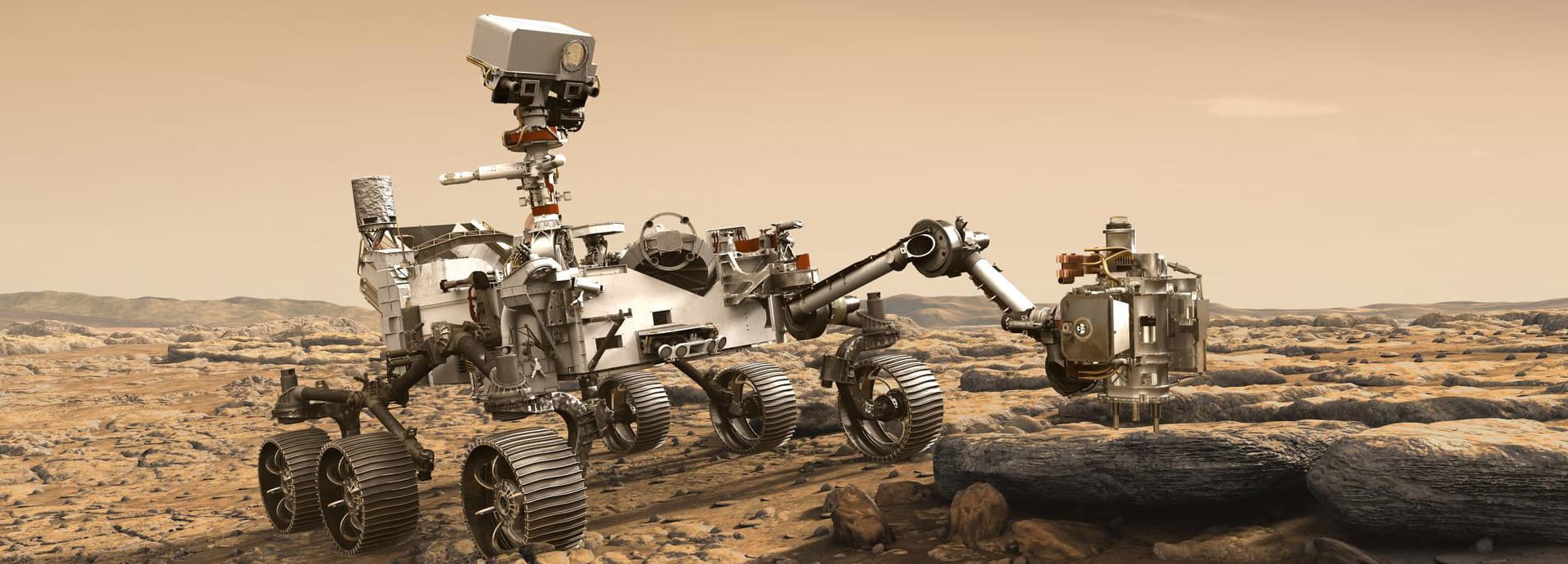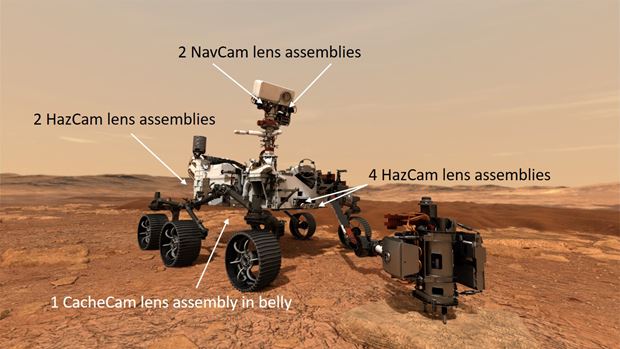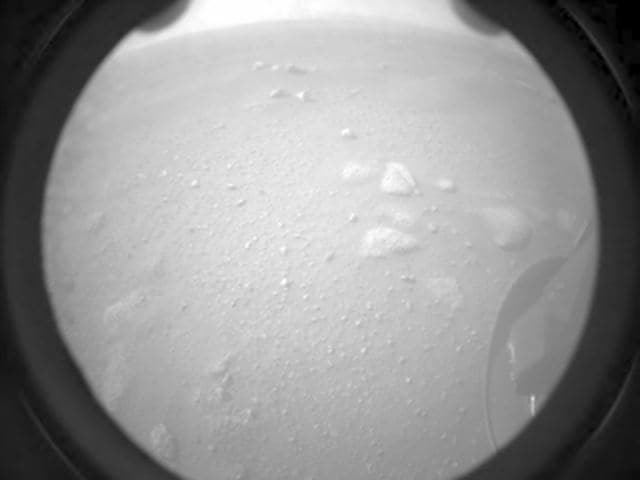- Mobility
- Digitization
Mars mission: These three different types of cutting edge lens assemblies will contribute to the success of NASA’s Rover "Perseverance"
A journey into space requires unique demands. Our engineers developed special lens assemblies for the Mars 2020 mission of NASA. Their Perseverance rover was launched in mid-2020 and landed on Mars in February 2021.
, Tamara WhittakerPioneers are the first to explore new territory. Our images of pioneers can be at opposite ends of the technological spectrum – from weather-beaten frontiersmen in dust-covered wagons to imaginative scientists in bright, sterile labs. However, few endeavors embody the pioneering spirit as much as NASA’s missions into space. And like the Apollo program, the public’s imagination has been captured by the quest for the exploration of Mars.
The latest Mars mission of NASA launched in July 2020, when Earth and the Red Planet were relatively close to one another. Central to this expedition is a new robotic exploration vehicle, the Mars 2020 Rover named Perseverance.
Based on NASA’s successful Curiosity Rover platform, the Perseverance Rover searches for historical signs of life and is beginning preparations for possible human colonization. At approximately 10 feet long and 7 feet tall, the 2020 Rover is about the size of an SUV. At just 2,000 pounds it is considerably lighter. It has an improved wheel design, its long-range mobility system will allow it to travel up to 13 miles on the Martian surface and an exciting new addition to its capabilities is a drill capable of penetrating rocks.

Three Extraordinary Engineering Lens Assemblies were developed for the Mars mission
To reduce cost, time and risk Perseverance utilizes about 85% of “heritage hardware” from the Mars Science Laboratory’s (MLS) Curiosity Rover. Among the new improvements, at the heart of this remarkable vehicle – guiding it, protecting it and enabling the collection of samples - are the Enhanced Engineering Cameras (EECAMs) with three new types of lens assemblies developed by Jenoptik in Jupiter, Florida.

Mars 2020 Rover showing the position of the lenses
- Two sets of stereo NavCams lens assemblies, or navigation lens assemblies, captured the first images from the mission and continue to transmit as the rover explores the surface. Mounted high on the mast, they enable remote operators to see where the rover is going, plus they play a crucial role when the rover drives autonomously. Capable of distinguishing objects as small as a golf ball at a distance of 80 feet, they ensure the vehicle chooses a safe course.
- The HazCams lens assemblies, or hazard avoidance lens assemblies, also provide stereo images, recognize boulders, holes and other potential obstacles such as sand dunes or trenches. There are 6 in total – two mounted on the back of the vehicle and four on the front. The front-mounted HazCams serve a dual purpose. They help the rover identify obstacles and allow engineers to see the movement of the robotic arm during sample collection.
- Mounted within the Rover’s belly, the CacheCam lens assemblies guide the collection and storage of the rock and soil samples as well as keeping photographic records of the sample gathering process. In addition to conducting physical and chemical analysis, the rover – with the aid of the CacheCam – packs samples into tubes and places them in a designated storage area on the planet’s surface. Future missions could potentially transport these samples to Earth for more detailed examination.
All three lens assembly types play a critical role in the Mars mission’s four key scientific goals:
- Assess the Martian Climate
- Conduct a geological study
- Prepare for manned expeditions
- Determine whether there was ever life on Mars
As a pioneer of optical technologies whose origins date back to Carl Zeiss and Ernst Abbe, Jenoptik is helping pave the way for possible human exploration of Mars by engineering and manufacturing mission-critical technologies for space exploration. From helping Perseverance navigate, avoid hazards while in motion and enabling the collection of samples, Jenoptik is at the forefront of delivering critical photonic technologies and products for human advancement.
The entire Jenoptik team is proud of the extraordinary lens assemblies that are roaming the Red Planet on the Perseverance Rover which were developed, assembled and tested at our facilities. With a long history of meeting extreme environments and mission critical performance requirements for applications including space exploration we are also proud to contribute to the knowledge of the Mars environment as well as ignite the imaginations of future scientists, engineers and innovators everywhere.
For more information on how Jenoptik can solve your unique optical engineering challenges contact us!
Images of the Mars Rover: © NASA/JPL-Caltech
First images of Mars captured by the Mars Rover Perseverance in the spring of 2021 (credits: NASA/JLP-Caltech)
Key facts about Mars

- Why is Mars often referred to as the Red Planet? Iron oxide prevalent on Mars gives it a reddish appearance.
- How big is Mars? Mars has a diameter of 4,220 miles (or approx. 6,800 kilometers). It is the second-smallest planet in the solar system.
- What is the temperature on Mars? On average the temperature is -55°C. The differences range from +27°C in summer to -133°C at the winter pole.
- How far away is our neighboring planet from Earth? The distance is between 56 million and more than 400 million kilometers. This figure is based on different planet speeds on their orbits around the sun.
- What does the surface of Mars look like? The surface of Mars is characterized by volcanic eruptions of bygone times and the impacts of meteorites, mountains, gorges and icy pole caps. An extinguished volcano of gigantic proportions is particularly striking: The diameter of the crater is 80 kilometers and the Olympus Mons is 26 kilometers tall. This makes it the largest volcano in the solar system.
- Why is Mars so exciting for research? Water and life are closely related on Earth. Water is the origin of life and there can be no living beings without water. Today, Mars is dry, but if there was once water on Mars, it is reasonable to assume that life existed there as well.
About Tamara Whittaker
Tamara Whittaker is the Marketing and Communications Manager responsible for marketing initiatives across Jenoptik’s divisions within the North American region. With over 15 years’ experience and a Bachelor of Science degree in Marketing, she aligns with other regions to help Jenoptik develop into a globally focused photonics group.













